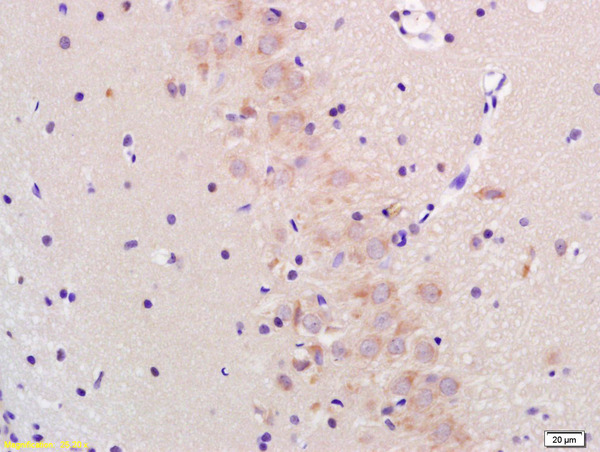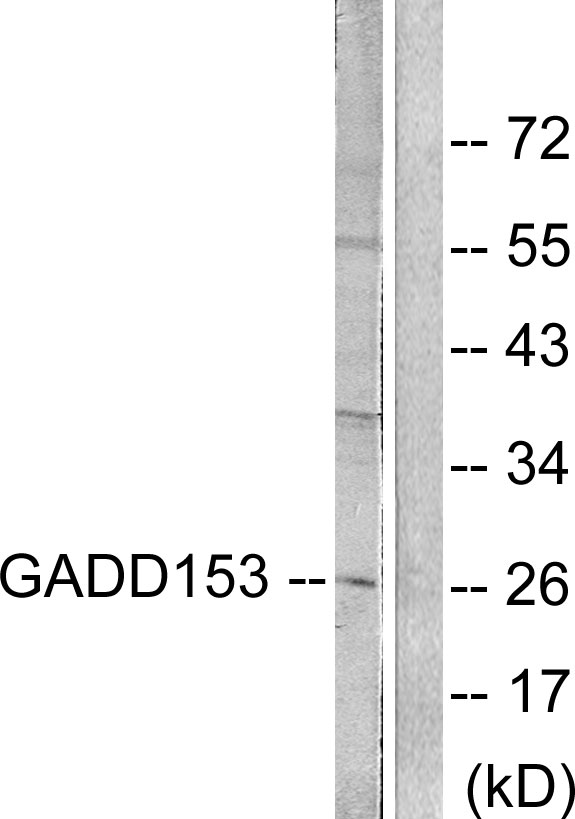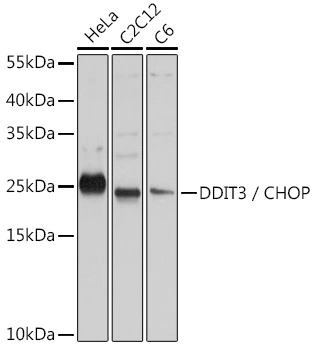![WB analysis of 30 ug of whole cell lysates from undifferentiated 3T3-L1 fibroblasts (Fib) and 3T3-L1 fibroblasts differentiated into adipocytes (Day 2 and Day 9 post-differentiation) using GTX11419 GADD153 antibody [9C8]. 3T3-L1 fibroblasts were cultured in differentiation medium for 3 days to generate adipocytes. Differentiated adipocytes were maintained in maturation media containing either 5mM glucose (normal glucose) or 30mM glucose (high glucose). Dilution : 1:1000 WB analysis of 30 ug of whole cell lysates from undifferentiated 3T3-L1 fibroblasts (Fib) and 3T3-L1 fibroblasts differentiated into adipocytes (Day 2 and Day 9 post-differentiation) using GTX11419 GADD153 antibody [9C8]. 3T3-L1 fibroblasts were cultured in differentiation medium for 3 days to generate adipocytes. Differentiated adipocytes were maintained in maturation media containing either 5mM glucose (normal glucose) or 30mM glucose (high glucose). Dilution : 1:1000](https://www.genetex.com/upload/website/prouct_img/normal/GTX11419/GTX11419_1466_WB_w_23060501_426.webp)
WB analysis of 30 ug of whole cell lysates from undifferentiated 3T3-L1 fibroblasts (Fib) and 3T3-L1 fibroblasts differentiated into adipocytes (Day 2 and Day 9 post-differentiation) using GTX11419 GADD153 antibody [9C8]. 3T3-L1 fibroblasts were cultured in differentiation medium for 3 days to generate adipocytes. Differentiated adipocytes were maintained in maturation media containing either 5mM glucose (normal glucose) or 30mM glucose (high glucose). Dilution : 1:1000
GADD153 antibody [9C8]
GTX11419
ApplicationsImmunoFluorescence, ImmunoPrecipitation, Western Blot, ImmunoCytoChemistry, ImmunoHistoChemistry, ImmunoHistoChemistry Frozen, ImmunoHistoChemistry Paraffin
Product group Antibodies
ReactivityHuman, Mouse, Rabbit, Rat
TargetDDIT3
Overview
- SupplierGeneTex
- Product NameGADD153 antibody [9C8]
- Delivery Days Customer9
- Application Supplier NoteWB: 1 microg/ml. IHC-Fr: 1:100. *Optimal dilutions/concentrations should be determined by the researcher.Not tested in other applications.
- ApplicationsImmunoFluorescence, ImmunoPrecipitation, Western Blot, ImmunoCytoChemistry, ImmunoHistoChemistry, ImmunoHistoChemistry Frozen, ImmunoHistoChemistry Paraffin
- CertificationResearch Use Only
- ClonalityMonoclonal
- Clone ID9C8
- Concentration1 mg/ml
- ConjugateUnconjugated
- Gene ID1649
- Target nameDDIT3
- Target descriptionDNA damage inducible transcript 3
- Target synonymsAltDDIT3, C/EBPzeta, CEBPZ, CHOP, CHOP-10, CHOP10, GADD153, DNA damage-inducible transcript 3 protein, C/EBP zeta, CCAAT/enhancer-binding protein homologous protein, alternative DDIT3 protein, c/EBP-homologous protein 10, growth arrest and DNA damage-inducible protein GADD153
- HostMouse
- IsotypeIgG2b
- Protein IDP35638
- Protein NameDNA damage-inducible transcript 3 protein
- Scientific DescriptionThis gene encodes a member of the CCAAT/enhancer-binding protein (C/EBP) family of transcription factors. The protein functions as a dominant-negative inhibitor by forming heterodimers with other C/EBP members, such as C/EBP and LAP (liver activator protein), and preventing their DNA binding activity. The protein is implicated in adipogenesis and erythropoiesis, is activated by endoplasmic reticulum stress, and promotes apoptosis. Fusion of this gene and FUS on chromosome 16 or EWSR1 on chromosome 22 induced by translocation generates chimeric proteins in myxoid liposarcomas or Ewing sarcoma. Multiple alternatively spliced transcript variants encoding two isoforms with different length have been identified. [provided by RefSeq, Aug 2010]
- ReactivityHuman, Mouse, Rabbit, Rat
- Storage Instruction-20°C or -80°C,2°C to 8°C
- UNSPSC12352203
References
- Monceaux K, Gressette M, Karoui A, et al. Ferulic Acid, Pterostilbene, and Tyrosol Protect the Heart from ER-Stress-Induced Injury by Activating SIRT1-Dependent Deacetylation of eIF2α. Int J Mol Sci. 2022,23(12). doi: 10.3390/ijms23126628Read this paper
- Guan P, Sun ZM, Luo LF, et al. Hydrogen protects against chronic intermittent hypoxia induced renal dysfunction by promoting autophagy and alleviating apoptosis. Life Sci. 2019,225:46-54. doi: 10.1016/j.lfs.2019.04.005Read this paper
- Takahashi N, Harada M, Hirota Y, et al. Activation of Endoplasmic Reticulum Stress in Granulosa Cells from Patients with Polycystic Ovary Syndrome Contributes to Ovarian Fibrosis. Sci Rep. 2017,7(1):10824. doi: 10.1038/s41598-017-11252-7Read this paper
- Su CC. Tanshinone IIA inhibits gastric carcinoma AGS cells through increasing p-p38, p-JNK and p53 but reducing p-ERK, CDC2 and cyclin B1 expression. Anticancer Res. 2014,34(12):7097-110.Read this paper

![WB analysis of HeLa cells were left untreated (-) or treated with tunicamycin (5 microg/ml) for 11 hours (+) using GTX11419 GADD153 antibody [9C8]. Dilution : 1:2000 WB analysis of HeLa cells were left untreated (-) or treated with tunicamycin (5 microg/ml) for 11 hours (+) using GTX11419 GADD153 antibody [9C8]. Dilution : 1:2000](https://www.genetex.com/upload/website/prouct_img/normal/GTX11419/GTX11419_1467_WB_w_23060501_411.webp)
![ICC/IF analysis of A549 cells treated with media only (non-treated) or with 1.5 microM tunicamycin for 6 hours using GTX11419 GADD153 antibody [9C8]. ICC/IF analysis of A549 cells treated with media only (non-treated) or with 1.5 microM tunicamycin for 6 hours using GTX11419 GADD153 antibody [9C8].](https://www.genetex.com/upload/website/prouct_img/normal/GTX11419/GTX11419_228_ICC-IF_w_23060501_948.webp)



